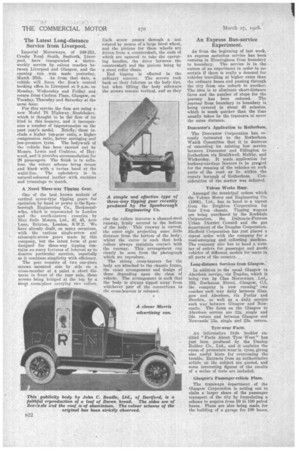The Latest Long-distance Service from Liverpool.
Page 84

If you've noticed an error in this article please click here to report it so we can fix it.
Imperial Motorways, of 249-251, Crosby Road South, Seaforth; Liverpool, have inaugurated a thriceweekly service by saloon coaches between Liverpool and Glasgow, and the opening run was made yesterday, March 26th. As from that date, a vehicle will leave the firm's central booking office in Liverpool at 9 a.m. vu Monday, Wednesday and Friday and return frets) Carlton Place, Glasgow, on Tuesday, Thursday and Saturday at the same -hour.
For this service the firm are using a new Model 76 Highway Studebaker, which is thought to be the first of its kind in this Country, and it incorporates a number of improvements on the past year's model. Briefly,-these in. elude a higher top-gear ratio, a higher compression ratio, better springing and low-pressure tyres. The bodywork of the vehicle has been • carried out by Messrs. Lewis and Crabtree, of Heywood, and it provides accommodation for 26 passengers. The finish is in cellulose, the colour scheme being cream and black with a tartan band at the
waist-line. The upholstery is in natural-coloured leather . with curtains and trimmings to match.
A Novel Three-way Tipping Gear.
One of the best known makers of vertical screw-type tipping gears for ,operation by hand or power is the Spenborough Engineering Co., Beckmondsvike, which is represented in London and the south-eastern counties by Blue Belle Motors, Ltd., 42, 45, Acre Lane, Brixton, London, S.W.2. We have already dealt, on many occasions. with the various single-screw and telescopic-screw gears made by this company, but the latest form of gear designed for three-way tipping contains ses many features of interest as to deserve particular mention, especially as it combines simplicity with efficiency.
The gear consists of two one-piece screws mounted side by side on a cross-member at a point a short distance in front of the rear axle, these screws being bridged at the top by a stout .cross-piece carrying two rollers. Each screw passes through a nut rotated by means of a large bevel wheel, and the pillions for these wheels are driven from a countershaft, the ends of which are squared to take the operating handles, the drive between the countershaft and the pinions being by a stout roller chain.
End tipping is effected in the ordinary . manner. The screws rock back on their fulcrum as the body tips, but when lifting the body sideways the screws remain vertical, and as they rise the rollers traverse a channel-steel runway, firmly secured to the bottom of the body. This runway is carved, the outer en's projecting some little distance from the bottom of the body ; whilst the curve is such that both rollers always maintain contact with the runway. This arrangement can clearly be seen from the photograph which we reproduce.
The strong cross-bearers for the body are attached to the chassis frame, the exact arrangement and design of these depending upon the class of vehicle. The arrangement is such that the body is always tipped away from whichever pair of the connections to the cross-bearers is released.




























































































































































































